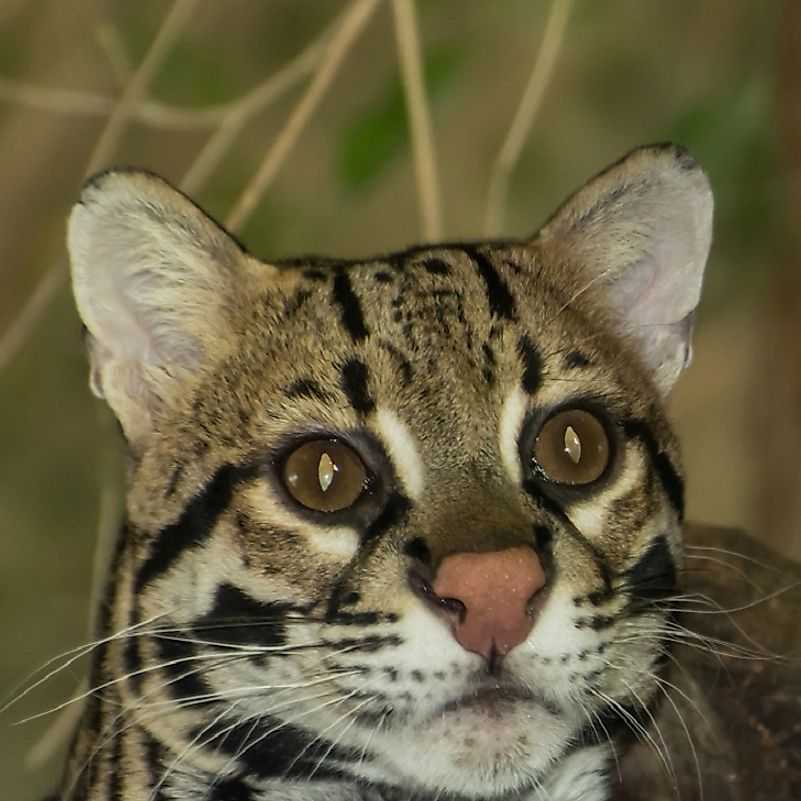Ocelot Facts: Animals of North America

5. Physical Description
The scientific name of the Ocelot, also known as the Dwarf leopard, is Leopardus pardalis. This wild mammal is a member of the Felidae (Cat) Family, and resembles a cross between a house cat, leopard, and jaguar. Among the mighty cat’s physical characteristics are round-shaped ears, large front paws, and sleek, smooth fur which is covered in blotch-like spots. As carnivores, Ocelots are keenly skilled hunters who have the ability to rip through the flesh of their prey, using their powerful, pointed fangs and razor sharp teeth. Most Ocelots measure 27 to 39 inches in length, and can reach a standing height of 16 to 20 inches at the shoulders. Mature Ocelots usually weigh between 18 and 40 pounds.
4. Diet
Because Ocelots are carnivorous, they subsist on a diet that is rich in meat. Ocelots are skillful hunters who prefer to search for their prey during the nighttime hours. The diet of these cats includes animals as varied as rodents (mice and rats), deer, fish, rabbits, reptiles, snakes, crabs, armadillos, anteaters, and frogs. These wild cats are also gifted with the ability to climb trees when in pursuit of such food sources as birds and monkeys. Unlike most felines, however, Ocelots don’t fear being in the water, and are in fact apt swimmers. Once they catch their prey, Ocelots proceed to rip their bodies into pieces, though they are even capable of swallowing some species of their prey whole. These wild cats use their rough tongues to clean a dead animal’s bones of their remaining flesh and tissue.
3. Habitat and Range
Ocelots are most commonly found on the continent of South America, but their full range extends from south Texas all the way down to Argentina. These wild cats live in an array of different habitats, including tropical jungles, forest, marshes, and grasslands. Ocelots are also known to inhabit certain high regions within the Andes Mountain Range. In the wild, Ocelots face the danger of being preyed upon by other predatory creatures that share their ranges, such as eagles and Anaconda snakes, as well as such other wild felines as jaguars and pumas. Ocelots also face major threats due to hunters, who pursue them in order to obtain these cats' distinctive and valuable furs. Factors such as habitat loss also play a major role in decreasing Ocelot populations. In the state of Texas, where they have been deemed to be an "Endangered" species, the number of Ocelots has dwindled dramatically.
2. Behavior
Ocelots are solitary and fiercely territorial animals, who assert their claim to ownership over a certain area by marking the space with their urine. As Ocelots are nocturnal hunters, it’s not surprising that Ocelots have excellent vision during both the daylight as well as the nighttime hours. Although Ocelots tend to be very active animals, during periods of rest they can often be found laying in trees, or under the protective cover of leafy foliage. Many of these wildcats live in peril due to the fact that they choose to live in areas close to human settlements, and thus must face dangers from hunters as well as factors such as vehicular traffic and other human activities. Despite being wild animals, Ocelots have also been kept as exotic pets. One famous owner of such a “pet” was the Spanish surrealist artist Salvador Dali.
1. Reproduction
Due to their solitary natures, male and female Ocelots only pair up in order to mate. When pregnant, the female retreats to the protective safety of a space such as a den or hollowed out tree. Litters usually consist of one or two newborns, and the gestation period for Ocelots lasts around 79 to 85 days. Kittens usually weigh slightly more than eight ounces at birth, and are solely dependent on their mothers to meet their nutritional needs. The young are able to leave the den by themselves at approximately three months of age. They become self-sufficient at approximately two years of age, when they can leave the safety of their mothers' sides and venture out on their own. In the wild, Ocelots have an estimated lifespan of seven to ten years, which increases further to 20 or more for cats kept in captivity.











